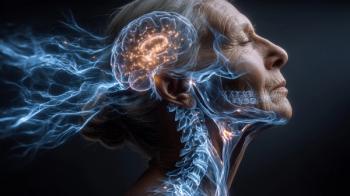
- Psychiatric Times Vol 19 No 11
- Volume 19
- Issue 11
Taking a New Look at Psychosis in Alzheimer's Disease
Patients with Alzheimer's disease and psychosis often have a more severe course of illness, with higher incidence of caregiver burden and hospitalization. Differentiating this disorder from Alzheimer's disease uncomplicated by psychosis is key to maximizing more positive outcomes.
Psychotic symptoms, namely hallucinations and delusions, are common in individuals with Alzheimer's disease (AD). This article will examine the proposal that Alzheimer's disease with psychosis (AD+P) has an underlying genetic and neurobiologic basis distinct from that of AD without psychosis.
Most estimates of the prevalence of psychosis in patients with AD range from 30% to 40% (Wragg and Jeste, 1989). Rates in community samples are similar (Lyketsos et al., 2000). The presence of psychotic symptoms can cause significant distress for the patient, as well as for family members and caregivers (Kaufer et al., 1998). Subjects with AD+P are also prone to aggressive behavior, further contributing to caregiver burden (Aarsland et al., 1996; Deutsch et al., 1991; Sweet et al., 2001b).
In addition to disruptive behavior, AD+P has been associated with more severe cognitive and functional deficits compared to patients who have AD without psychosis who are matched on other clinical characteristics (Jeste et al., 1992; Paulsen et al., 2000a; Stern et al., 1987). Alzheimer's disease with psychosis is also associated with more rapid cognitive and functional deterioration (Drevets and Rubin, 1989; Levy et al., 1996; Paulsen et al., 2000b). Finally, AD+P is a predictor of premature institutionalization (Lopez et al., 1999; Magni et al., 1996). The association between psychosis and excess cognitive impairment in AD is similar to that seen in idiopathic disorders (e.g., schizophrenia and major depression with psychotic features) and suggests the possibility of a common mechanism (Jeste et al., 1996; Sweet and Pollock, 1999).
Until recently, conventional neuroleptics were the first-line treatment for AD+P, despite having only moderate efficacy (Schneider et al., 1990) and substantial side effects in the elderly, including high rates of tardive dyskinesia even after brief treatment (Jeste et al., 1995) and increased rates of neuroleptic-induced parkinsonism (Sweet et al., 1996). These liabilities have led to the emergence of atypical antipsychotic medications as current first-line treatment. These agents offer an improved side-effect profile, although their efficacy is not substantially greater (De Deyn et al., 1999; Katz et al., 1999; Street et al., 2000). Despite treatment, many patients still fail to respond or continue to have persistent symptoms.
The development of innovative, specific and markedly more efficacious treatments for AD+P will likely require understanding of its specific biologic processes. Identification of these processes may also uncover mechanisms of cognitive impairment, with implications not only for AD but also for idiopathic psychoses. In addition, although the genetic architecture of AD remains mostly undetermined, it is likely that the effort to map liability genes for AD will be enhanced by use of readily defined, biologically homogeneous subgroups, one of which may be defined by AD+P (Sweet et al., in press).
Controversies
Prior to embarking on a neurobiologic or genetic examination of AD+P, three important concerns need to be addressed: 1) Can psychotic symptoms in AD be readily and reliably identified? 2) Are psychotic symptoms merely a nonspecific consequence of disease progression? and 3) Are psychotic symptoms in AD a state or trait?
The definition of psychotic symptoms in AD has generally been limited to delusions and hallucinations. A wide variety of delusions have been reported in AD (Rubin et al., 1988; Tariot et al., 1995). Hallucinations in AD can occur in any sensory modality, but visual and auditory hallucinations are most common. Disorganized thought processes are not considered to represent a psychotic thought disorder, but rather are attributed to the cognitive impairments of AD.
Determining the presence of delusions in AD can be clinically challenging. Many putative delusions (e.g., theft, infidelity, abandonment) may actually be accurate interpretations of real events. Delusions must be distinguished from simple forgetting by further evaluation. Was the information ever encoded in memory? A patient with moderate or severe AD is unlikely to sustain memory of an event that occurs while in this stage. Additional characteristics, such as whether the individual refuses to accept reality-testing and whether the false idea is persistent over time, are useful in distinguishing delusions (Devanand et al., 1992). Although no absolute standard definition of persistence over time exists, the criteria used have ranged from more than two or three episodes in a week (Devanand et al., 1992; Sweet et al., 1998) to repeated episodes persistent for at least one month (Burns et al., 1990; Jeste and Finkel, 2000).
Determining the presence of hallucinations in patients with AD presents different challenges. Because of expressive language difficulties, it may not be clear whether an individual with AD is indeed hallucinating or experiencing illusions or agnosias. Nocturnal hallucinations can be especially challenging. Hallucinations that transiently occur upon falling asleep or awakening can be normal phenomena, but it may not be possible to make this distinction in a patient with AD. Finally, care must be taken to exclude the possibility that hallucinations (and delusions) are not solely limited to a period of acute delirium or a transient medication-induced state (Jeste and Finkel, 2000).
Despite the challenges inherent in correctly identifying psychotic symptoms in AD, most evidence indicates that this attribution can be made reliably. The inter-rater reliability for measuring the severity of individual psychotic symptoms in AD subjects is generally high (Cummings, 1997; Mack and Patterson, 1994). Inter-rater and test-retest reliability for the classification of a subject as having AD+P is similarly high (Sweet et al., in press).
There is fairly consistent evidence that psychotic symptoms rarely occur during the prodromal phase of AD, occur infrequently in the early stages of illness (Rubin and Kinscherf, 1989) and increase in frequency as the illness progresses to the moderate stage (Cohen-Mansfield et al., 1998; Devanand et al., 1997). The evidence is less consistent regarding late-stage illness. Post-mortem studies have reported AD+P rates of approximately 40% to 60%, indicating that not all subjects with AD progress to AD+P (Sweet et al., 2000). Similarly, AD+P has not consistently been associated with more severe or widespread neuropathologic changes at autopsy. Thus, AD+P does not appear to be an inevitable (and nonspecific) consequence of progression to later disease stages, but rather affects only a subset of AD patients.
Alzheimer's disease with psychosis has been defined by the presence of psychotic symptoms that persist for at least several weeks (Jeste and Finkel, 2000). This criterion guards against misclassification of brief psychotic symptoms that arise due to transient states. To be considered a trait, however, psychotic symptoms should persist longer than several weeks. A number of studies have examined the long-term persistence of AD+P, ranging in duration of follow-up from six months to five years (Devanand et al., 1997). Although results vary by study, all found either the presence of AD+P or the severity of psychotic symptoms to be at least moderately persistent over time, consistent with identification of a trait. Levy et al. (1996) found that the one-year recurrence rate of AD+P was 95%. This finding suggests that psychosis in AD is a trait and not a state-dependent phenomenon.
If psychosis represents a readily and reliably identifiable trait affecting about half of all subjects with AD, the hypothesis that there are unique genetic and neurobiologic determinants of AD+P can readily be tested. While there are many levels of evidence for genetic determination, first and foremost is whether the trait is heritable. We recently examined the familial aggregation of AD+P in a cohort of 371 AD probands and 461 of their siblings also diagnosed with AD (Sweet et al., 2002a). There was a significant association between the presence of psychotic symptoms in probands and in their siblings. The odds ratio (OR) for any occurrence of psychotic symptoms in siblings with AD was 2.4 (95% CI: 1.46-4.00; p<0.001), an association that was strengthened when using a more restrictive definition of AD+P requiring multiple and/or persistent symptoms (OR 3.18; CI: 2.17-4.66; p=0.0006). We followed up this finding with genome-wide multipoint linkage analysis in those families with two or more individuals with restrictively defined AD+P (Bacanu et al., 2002). Because the most important identified genetic risk factor for late-onset AD is the presence of one or more E4 alleles for the apolipoprotein E gene (APO E4), we restricted the analysis to the families in which at least two individuals also had one or more E4 alleles. We found evidence for significant linkage on chromosome 2p and suggestive linkages on chromosomes 6q and 21q.
An alternate approach to identifying a genetic basis for AD+P is to examine whether candidate genes, selected for possible contribution to psychotic symptoms based on knowledge of their function, are associated with AD+P. Polymorphic variation in the genes for the dopamine1 and dopamine3 receptors (DRD1 and DRD3) (Holmes et al., 2001; Sweet et al., 1998), the serotonin2A and serotonin2C receptors (5-HT2A and 5-HT2C) (Holmes et al., 1998), and long alleles of the serotonin transporter gene (5-HTT or SLC6A4) (Sweet et al., 2001b) have been found to confer moderate but significant increases in risk for AD+P. One of these genes, DRD3 has also been associated with a small but significant increase in the risk of schizophrenia in both case-control and family studies (Williams et al., 1998).
There is emerging neurobiologic evidence suggesting that AD+P is associated with excess neocortical pathology. Functional imaging studies in vivo have found that subjects with AD+P demonstrate excess impairment of frontal, temporal and parietal cerebral blood flow and glucose metabolism in comparison to AD subjects without psychosis (Starkstein et al., 1994; Sultzer et al., 1995). We recently examined post-mortem magnetic resonance spectroscopy in subjects with AD+P, finding significant reductions in neocortical N-acetyl-L-aspartate (NAA, a marker of neuronal integrity) concentrations, with superior temporal, dorsolateral prefrontal and inferior parietal cortex most affected (Sweet et al., 2002b). Subjects with AD+P also demonstrated significant elevations in concentrations of the phosphodiester membrane breakdown product glycerphosphoethanolamine compared to subjects without psychosis. It is noteworthy that similar observations have been emerging in the study of subjects with schizophrenia, in whom studies have also found reduced NAA concentrations and elevated concentrations of phosphodiesters (Keshavan et al., 2000). Similarly, post-mortem studies of subjects with schizophrenia have found evidence of reduced pyramidal cell volume (Pierri et al., 2001; Rajkowska et al., 1998; Sweet et al., 2001a) and reduced numbers of synaptic components in neocortical regions (Garey et al., 1998; Glantz and Lewis, 1997; Rosoklija et al., 2000). Thus, just as psychosis is associated with cognitive impairment in both schizophrenia and AD, there may be factors affecting neuronal and synaptic integrity and number that underlie psychosis in both disorders.
Summary
An emerging body of evidence indicates that AD+P identifies a clinically relevant subtype, characterized by an increased rate of cognitive deterioration, a liability toward aggressive behavior, greater caregiver burden and premature institutionalization. Efforts to identify the distinct genetic and neurobiologic determinants of AD+P are still in the early stages, although some promising leads are already emerging. For example, the association between AD+P and genetic variation in serotonin system receptors might not have been expected, but is consistent with emerging evidence that the selective serotonin reuptake inhibitors provide therapeutic benefit for agitated and psychotic symptoms in subjects with AD+P (Pollock et al., 2002). Whether study of AD+P will lead to additional insights into the biology of psychotic symptoms in AD, and in other psychotic disorders, remains to be determined.
References:
References1. Aarsland D, Cummings JL, Yenner G, Miller B (1996), Relationship of aggressive behavior to other neuropsychiatric symptoms in patients with Alzheimer's disease. Am J Psychiatry 153(2):243-247.
2. Bacanu SA, Devlin B, Chowdari KV et al. (2002), Linkage analysis of Alzheimer disease with psychosis. Neurology 59(6):118-120 [see comment].
3. Burns A, Jacoby R, Levy R (1990), Psychiatric phenomena in Alzheimer's disease. I: Disorders of thought content. Br J Psychiatry 157:72-76, 92-94 [see comment].
4. Cohen-Mansfield J, Taylor L, Werner P (1998), Delusions and hallucinations in an adult day care population. A longitudinal study. Am J Geriatr Psychiatry 6(2):104-121.
5. Cummings JL (1997), The neuropsychiatric inventory: assessing psychopathology in dementia patients. Neurology 48(5 suppl 6):S10-S16.
6. De Deyn PP, Rabheru K, Rasmussen A et al. (1999), A randomized trial of risperidone, placebo, and haloperidol for behavioral symptoms of dementia. Neurology 53(5):946-955 [see comment].
7. Deutsch LH, Bylsma FW, Rovner BW et al. (1991), Psychosis and physical aggression in probable Alzheimer's disease. Am J Psychiatry 148(9):1159-1163.
8. Devanand DP, Jacobs DM, Tang MX et al. (1997), The course of psychopathologic features in mild to moderate Alzheimer disease. Arch Gen Psychiatry 54(3):257-263.
9. Devanand DP, Miller L, Richards M et al. (1992), The Columbia University Scale for Psychopathology in Alzheimer's disease. Arch Neurol 49(4):371-376.
10. Drevets WC, Rubin EH (1989), Psychotic symptoms and the longitudinal course of senile dementia of the Alzheimer type. Biol Psychiatry 25(1):39-48.
11. Garey LJ, Ong WY, Patel TS et al. (1998), Reduced dendritic spine density on cerebral cortical pyramidal neurons in schizophrenia. J Neurol Neurosurg Psychiatry 65(4):446-453 [see comment].
12. Glantz LA, Lewis DA (1997), Reduction of synaptophysin immunoreactivity in the prefrontal cortex of subjects with schizophrenia: regional and diagnostic specificity. [Corrected and republished article originally appeared in 54(7):660-660.] Arch Gen Psychiatry 54(10):943-952.
13. Holmes C, Arranz MJ, Powell JF et al. (1998), 5-HT2A and 5-HT2C receptor polymorphisms and psychopathology in late onset Alzheimer's disease. Hum Mol Gen 7(9):1507-1509.
14. Holmes C, Smith H, Ganderton R et al. (2001), Psychosis and aggression in Alzheimer's disease: the effect of dopamine receptor gene variation. J Neurol Neurosurg Psychiatry 71(6):777-779 [see comment].
15. Jeste DV, Caligiuri MP, Paulsen JS et al. (1995), Risk of tardive dyskinesia in older patients. A prospective longitudinal study of 266 outpatients. Arch Gen Psychiatry 52(4):756-765.
16. Jeste DV, Finkel SI (2000), Psychosis of Alzheimer's disease and related dementias. Diagnostic criteria for a distinct syndrome. Am J Geriatr Psychiatry 8(1):29-34 [see comment].
17. Jeste DV, Heaton SC, Paulsen JS et al. (1996), Clinical and neuropsychological comparison of psychotic depression with nonpsychotic depression and schizophrenia. Am J Psychiatry 153(4):490-496 [see comment].
18. Jeste DV, Wragg RE, Salmon DP et al. (1992), Cognitive deficits of patients with Alzheimer's disease with and without delusions. Am J Psychiatry 149(2):184-189.
19. Katz IR, Jeste DV, Mintzer JE et al. (1999), Comparison of Risperidone and placebo for psychosis and behavioral disturbances associated with dementia: a randomized, double-blind trial. Risperidone Study Group. J Clin Psychiatry 60(2):107-115.
20. Kaufer DI, Cummings JL, Christine D et al. (1998), Assessing the impact of neuropsychiatric symptoms in Alzheimer's disease: the Neuropsychiatric Inventory Caregiver Distress Scale. J Am Geriatr Soc 46(2):210-215.
21. Keshavan MS, Stanley JA, Pettegrew JW (2000), Magnetic resonance spectroscopy in schizophrenia: methodological issues and findings-part II. Biol Psychiatry 48(5):369-380.
22. Levy ML, Cummings JL, Fairbanks LA et al. (1996), Longitudinal assessment of symptoms of depression, agitation, and psychosis in 181 patients with Alzheimer's disease. Am J Psychiatry 153(11):1438-1443.
23. Lopez OL, Wisniewski SR, Becker JT et al. (1999), Psychiatric medication and abnormal behavior as predictors of progression in probable Alzheimer disease. Arch Neurol 56(10):1266-1272.
24. Lyketsos CG, Steinberg M, Tschanz JT (2000), Mental and behavioral disturbances in dementia: findings from the Cache County Study on Memory in Aging. Am J Psychiatry 157(5):708-714.
25. Mack JL, Patterson MB (1994), The evaluation of behavioral disturbances in Alzheimer's disease: the utility of three rating scales. J Geriatr Psychiatry Neurol 7(2):99-115.
26. Magni E, Binetti G, Bianchetti A, Trabucchi M (1996), Risk of mortality and institutionalization in demented patients with delusions. J Geriatr Psychiatry Neurol 9(3):123-126.
27. Paulsen JS, Ready RE, Stout JC et al. (2000a), Neurobehaviors and psychotic symptoms in Alzheimer's disease. J Int Neuropsychol Soc 6(7):815-820.
28. Paulsen JS, Salmon DP, Thal LJ et al. (2000b), Incidence of and risk factors for hallucinations and delusions in patients with probable AD. Neurology 54(10):1965-1971 [see comment].
29. Pierri JN, Volk CL, Auh S et al. (2001), Decreased somal size of deep layer 3 pyramidal neurons in the prefrontal cortex of subjects with schizophrenia. Arch Gen Psychiatry 58(5):466-473.
30. Pollock BG, Mulsant BH, Rosen J et al. (2002), Comparison of citalopram, perphenazine, and placebo for the acute treatment of psychosis and behavioral disturbances in hospitalized, demented patients. Am J Psychiatry 159(3):460-465.
31. Rajkowska G, Selemon LD, Goldman-Rakic PS (1998), Neuronal and glial somal size in the prefrontal cortex: a postmortem morphometric study of schizophrenia and Huntington disease. Arch Gen Psychiatry 55(3):215-224.
32. Rosoklija G, Toomayan G, Ellis SP et al. (2000), Structural abnormalities of subicular dendrites in subjects with schizophrenia and mood disorders: preliminary findings. Arch Gen Psychiatry 57(4):349-356.
33. Rubin EH, Drevets WC, Burke WJ (1988), The nature of psychotic symptoms in senile dementia of the Alzheimer type. J Geriatr Psychiatry Neurol 1(1):16-20.
34. Rubin EH, Kinscherf DA (1989), Psychopathology of very mild dementia of the Alzheimer type. Am J Psychiatry 146(8):1017-1021.
35. Schneider LS, Pollock VE, Lyness SA (1990), A metaanalysis of controlled trials of neuroleptic treatment in dementia. J Am Geriatr Soc 38(5):553-563.
36. Starkstein SE, Vazquez S, Petracca G et al. (1994), A SPECT study of delusions in Alzheimer's disease. Neurology 44(11):2055-2059.
37. Stern Y, Mayeux R, Sano M et al. (1987), Predictors of disease course in patients with probable Alzheimer's disease. Neurology 37(10):1649-1653.
38. Street JS, Clark WS, Gannon KS et al. (2000), Olanzapine treatment of psychotic and behavioral symptoms in patients with Alzheimer disease in nursing care facilities: a double-blind, randomized, placebo-controlled trial. The HGEU Study Group. Arch Gen Psychiatry 57(10):968-976.
39. Sultzer DL, Mahler ME, Mandelkern MA et al. (1995), The relationship between psychiatric symptoms and regional cortical metabolism in Alzheimer's disease. J Neuropsychiatry Clin Neurosci 7(4):476-484.
40. Sweet RA, Hamilton RL, Lopez OL et al. (2000), Psychotic symptoms in Alzheimer's disease are not associated with more severe neuropathologic features. Int Psychogeriatr 12(4):547-558.
41. Sweet RA, Mulsant BH, Pollock BG et al. (1996), Neuroleptic-induced parkinsonism in elderly patients diagnosed with psychotic major depression and dementia of the Alzheimer's type. American Journal of Geriatric Psychiatry 4:311-319.
42. Sweet RA, Nimgaonkar VL, Devlin B, Jeste DV (in press), Psychotic symptoms in Alzheimer disease: evidence for a distinct phenotype. Mol Psychiatry.
43. Sweet RA, Nimgaonkar VL, Devlin B et al. (2002a), Increased familial risk of the psychotic phenotype of Alzheimer disease. Neurology 58(6):907-911.
44. Sweet RA, Nimgaonkar VL, Kamboh MI et al. (1998), Dopamine receptor genetic variation, psychosis, and aggression in Alzheimer's disease. [Published erratum Arch Neurol 59(6):1042.] Arch Neurol 55(10):1335-1340.
45. Sweet RA, Panchalingam K, Pettegrew JW et al. (2002b), Psychosis in Alzheimer disease: postmortem magnetic resonance spectroscopy evidence of excess neuronal and membrane phospholipid pathology. Neurobiol Aging 23(4):547-553.
46. Sweet RA, Pierri JN, Lewis DA (2001a), Deep layer 3 pyramidal cell somal volume is reduced in auditory association cortex (area PAAI) of subjects with schizophrenia. Presented at the Society for Neuroscience 31st Annual Meeting. San Diego; Nov. 10-15.
47. Sweet RA, Pollock BG (1999), Late-life psychosis: advances in understanding and treatment. In: Annual Review of Gerontology and Geriatrics, Vol. 19: Focus on Psychopharmacologic Interventions in Late Life, Katz I, Oslin D, eds. New York: Springer Publishing Company.
48. Sweet RA, Pollock BG, Sukonick DL et al. (2001b), The 5-HTTPR polymorphism confers liability to a combined phenotype of psychotic and aggressive behavior in Alzheimer disease. Int Psychogeriatr 13(4):401-409.
49. Tariot PN, Mack JL, Patterson MB et al. (1995), The Behavior Rating Scale for Dementia of the Consortium to Establish a Registry for Alzheimer's Disease. The Behavioral Pathology Committee of the Consortium to Establish a Registry for Alzheimer's Disease. Am J Psychiatry 152(9):1349-1357.
50. Williams J, Spurlock G, Holmans P et al. (1998), A meta-analysis and transmission disequilibrium study of association between the dopamine D3 receptor gene and schizophrenia. [Published erratum Mol Psychiatry 3(5):458.] Mol Psychiatry 3(2):141-149.
51. Wragg RE, Jeste DV (1989), Overview of depression and psychosis in Alzheimer's disease. Am J Psychiatry 146(5):577-587.
Articles in this issue
about 23 years ago
Health Care Faces Malpractice Crisisabout 23 years ago
Numbing Outabout 23 years ago
Commentary Investigating Psychiatric Abusesabout 23 years ago
Wounds Poemabout 23 years ago
An Overview of Diagnostic Toolsabout 23 years ago
Using Complementary Treatmentsabout 23 years ago
The Role of B Vitamins, Homocysteine in AD and Vascular DementiaNewsletter
Receive trusted psychiatric news, expert analysis, and clinical insights — subscribe today to support your practice and your patients.














